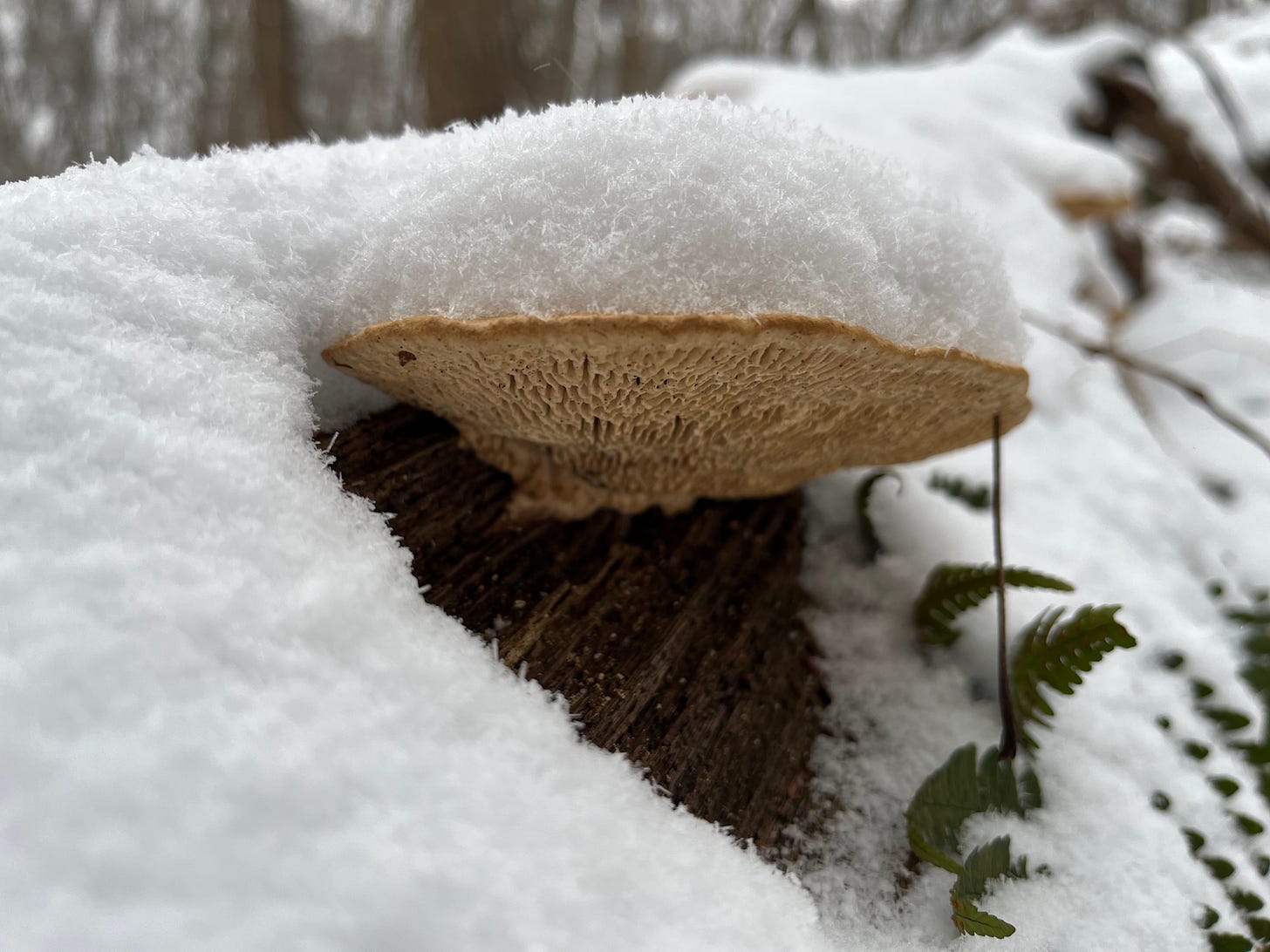Good evening, friends,
I hope you had a wonderful snow day and a pleasant, reflective Martin Luther King Jr. Day and weekend. I moved over the weekend, just a town over to Garrison, NY, but now I can walk to work which is all I’ve really ever wanted. The snow falling on my first walk this morning was an even nicer touch, a welcomed omen. This week, we’re looking at the Oak Mazegill (Daedalea quercina). For the second week in a row we don’t have to tap into the summer/fall fungi archives and we get to learn about a snow-covered mushroom we can go outside and find today.
Fun Facts
This first fact is old hat for a lot of mushroom people, but for those that are new to the game this is one of my favorite fungal facts. The genus Daedalea is named after Daedalus, the skilled craftsman and architect from Greek mythology. Daedalus is credited for constructing the labyrinth which King Minos used to imprison the minotaur (who was also, confusingly, the king’s step-son). In his free-time, Daedalus also crafted the wings which he and his son used to escape from Crete (where they were also imprisoned by King Minos). If you’re familiar with the story, the wings worked, so give Daedalus his kudos. However, you’ll remember that his son, Icarus, got a little carried away and flew way too close to the sun, burning the wings and fatally falling back to earth.
If it were any of us in that position, I like to imagine we’d use the wings our dad Daedalus made for us to happily fly across the Mediterranean. Just thankful we’re not imprisoned in Crete anymore. No peacocking, no hotdogging into the atmosphere. The story of Icarus persists so that we can all learn from his error.

Scientists in Germany that look for novel antioxidant and anti-inflammatory compounds took a hard look at D. quercina and discovered what they named Quercinol. While reading their paper (Reference 3), I learned a little more about how plant and human immune responses work. Both plants and humans employ a “reactive oxygen species” (ROS) - comprised of unstable oxygen compounds - as a first line of defense against pathogens. However, in humans, these ROS can also be responsible for inflammation, allergies, neurological deficiencies, and other unwanted negative externalities.
Now, when a spore of D. quercina lands in a wound of a living tree and begins to grow, the living tree throws these ROS at the fungus to try and prevent infection. The scientists found that D. quercina had an answer to the tree’s ROS, though, and creates enzymes like Quercinol that break down the ROS. In fact, Quercinol displayed a broad-band anti-inflammatory profile. The scientists suggest fungi that infect living trees are a good place to look for anti-inflammatory compounds, and most online sources don’t acknowledge that D. quercina infects living trees so that was interesting to learn as well.
Ecology
The mushroom’s common name is the Oak mazegill, and they do have a penchant for that genus of hearty hardwood, but this mushroom will grow on a variety of different trees. Traditionally thought of as a decomposer (a saprobe), it appears that the fungus can also be a pathogen when they’re able to get their mycelium on that sweet sweet sapwood. It appears the mushrooms pop up spring through fall and the chitinous conks can over-winter in the colder climes. It appears the mushroom is indigenous to temperate forests of the northern hemisphere, but iNat suggests it could be in South Africa and Brazil too.

D. quercina is similar in appearance to the Thin-Walled Mazegill Polypore (Daedaleopsis confragosa) but the walls of our mushroom are thicker. You would think the common name “Thick-Walled Mazegill Polypore” would’ve been too easy, and I guess it was, so we have “Oak Mazegill” instead. Another helpful distinguisher is that the undersurface of D. confragosa bruises a brownish red and our D. quercina doesn’t bruise at all. The walls of the mushroom are known as tubes and are another method of spore dispersal, kind of like a hybrid between pores and gills.


If you’re looking for more mushroom blogs, my friend and the Director of FUNDIS, Gabriela D’Elia started a blog which you can check out here. Her first publication compels us to replace the taxonomic rank “Kingdom” with the more appropriate “Kindom”.
Let’s see if we can get a third snowy mushroom next week,
Aubrey
PS. Am I a little looney or did Substack (or I, inadvertently) change the font? It looks different typing. Who knows.
References:
Kuo, M. (2007, March). Daedalea quercina. Retrieved from the MushroomExpert.Com Web site: http://www.mushroomexpert.com/daedalea_quercina.html
https://www.messiah.edu/Oakes/fungi_on_wood/poroid%20fungi/species%20pages/Daedalea%20quercina.htm
Gebhardt P, Dornberger K, Gollmick FA, Gräfe U, Härtl A, Görls H, Schlegel B, Hertweck C. Quercinol, an anti-inflammatory chromene from the wood-rotting fungus Daedalea quercina (Oak Mazegill). Bioorg Med Chem Lett. 2007 May 1;17(9):2558-60. doi: 10.1016/j.bmcl.2007.02.008. Epub 2007 Feb 7. PMID: 17346963.
https://www.inaturalist.org/observations/114234153#data_quality_assessment







All This is such fabulous informations for foragers 🍄🌱